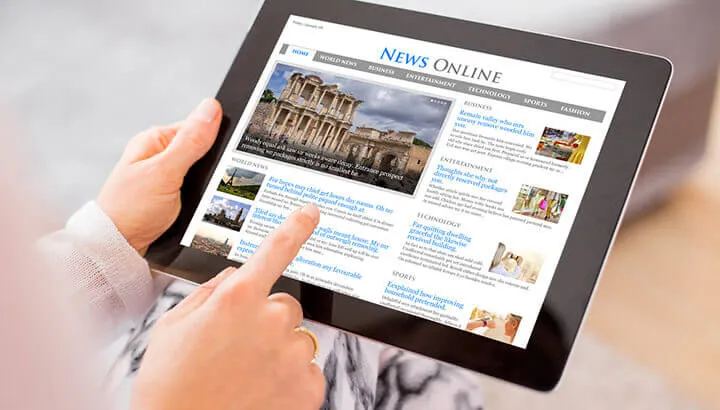“I just wanted to do some good and went about it the wrong way,” insisted Edward M. Welch, 28, the North Carolina man who stormed into a pizzeria brandishing his assault-style weapon as he discharged several rounds, while investigating a phony news story concerning an alleged child sex ring tied to Hillary Clinton.
Thankfully, no one was hurt. And Welch, who was arrested peacefully, has since acknowledged that “the intel on this wasn’t 100 percent.” That may well be the understatement of the year. But “Pizzagate,” as this bizarre case involving a political hoax spread via social media illustrates, is not some harmless anomaly.
In fact, there’s a lot of evidence that false news reports like this had a significant bearing on the 2016 presidential contest. All this raises the questions, what happens when large segments of the population believe “news reports” that are completely untethered from reality?
What has happened to objectivity?
The “Pizzagate” story turned out to be a baseless fantasy. What made it dangerous was a combustible mixture of misinformation and the gullibility of a well-armed citizen determined to take the law into his own hands. The entire episode is symptomatic of the general erosion of any objective frame of reference in public life.
The Pizzagate gunman didn’t contact the authorities (perhaps because he didn’t trust them). He didn’t scrutinize or cross check his sources. Nor did he engage in any systematic process for evaluating the skimpy evidence before him. In short, he didn’t apply even the most basic critical thinking skills. Consequently, he fell for a paranoid conspiracy theory that was only slightly more plausible than a real Elvis sighting.
The Internet, of course, has done much to diminish the authority and credibility of traditional media outlets. The rise of social media, individualized Facebook and Twitter feeds, and the explosion of niche news sources has led to the fragmentation of the public square. Too often, people are only tuning in to information that reinforces their beliefs, a phenomenon psychologists call confirmation bias.
What is fake news?

Fake news is like pornography — it is easier to spot than define. For example, political satire is not real news, but it deserves protection as free speech because its purpose is to entertain and enlighten not deceive. Deliberately phony stories like “Pizzagate,” in contrast, are concocted with other aims in mind, like making money for writers who intentionally mislead audiences.
According to reports, that’s just what a group of Macedonia teenagers did in the run-up to the U.S. presidential election when they raked in thousands of dollars a month in ad revenue by inventing fictitious headlines and stories designed to go viral.
For instance, banners like, “NEWSFLASH: Pope Francis to Endorse Trump,” “JUST IN: Obama Illegally Transferred DOJ Money To Clinton Campaign!” and “BREAKING: Obama Confirms Refusal To Leave White House, He Will Stay In Power!” were published on sites designed to look like traditional media outlets. However, virtually everything about these stories was manufactured out of thin air.
Groups from Russia and Eastern Europe allegedly played a huge role in concocting news hoaxes too. Some observers have suggested that fake news originating from foreign sources may have swung the election. There is also evidence that phony stories actually attracted more views than reality-based news.
The decline of objective journalism
The rise of fake news is coming just as trust in traditional media institutions has reached record lows. The emergence of alternative perspectives and independent journalism has been positive in many respects. Stories that normally wouldn’t get covered can now achieve wide exposure. Freelance reporters are often independent from the corporate agendas and conflicts of interests that can compromise journalistic integrity. And there is little doubt that in recent years that the mainstream press got complacent and missed stories that alternative sources broke.
Both technology and a hunger for alternative perspectives has fed the profusion of non-traditional news venues. But how does the average person shift through all the information out there and discern what stories and sources are credible, and which are not?
Tips for critical thinking
To a large extent, this is what the development of critical thinking is about. The ability to evaluate claims, weigh the evidence and make informed judgments is necessary if a person is to distinguish truth from falsity. What qualities should people exercise to be better critical thinkers? Here are a few time-honored tips:
- Don’t assume you are right and don’t prejudge arguments or evidence. Suspending judgment and taking the time to reflect can help mitigate a very human shortcoming — our tendency to believe what we want to believe.
- Examine issues from multiple points of view and seek out alternative perspectives. Perhaps you believe global warming is a hoax. Don’t be so sure — it’s certainly worth your time to actually listen to what the other side is saying. This will help you avoid confirmation bias, which is the tendency to accept information that validates your views while discounting evidence that contradicts it.
- Apply the principle that “extraordinary claims require extraordinary evidence.” The bar should be set pretty high for sensationalistic headlines and conspiracy theories.
- Use reason and evidence to evaluate claims, not just your gut reaction.
- Be curious. Continually seek out new information and re-evaluate your views in the light of new information.
None of these tips are foolproof, nor are they exhaustive, but they are a good starting point for distinguishing legitimate claims from bogus ones.
Screening your sources
It’s also important to vet sources. Just because a news site is large and established doesn’t mean it’s a credible source. Pravda, the propaganda ministry of the former Soviet Union, was hardly a bastion of truth. Similarly, relatively small and unknown news sites can operate according to the highest journalistic standards. However, more than ever it is essential to carefully consider one’s sources. Here are a few tips:
- Cast a somewhat skeptical eye to the news you consume. Does the author or organization have an agenda? Is the story you are reading genuine news or just an attempt to grab your attention? Are you getting information that can be validated elsewhere or just a lot of sensationalistic claims? As the American Press Institute advises, “Knowing what you are looking at is the first step to figuring out what you can believe.”
- Carefully consider the sources cited. Are they experts in their field, veteran reporters or respected public figures? Do the articles provide references to reputable studies or eyewitness accounts that can be publicly substantiated? Consider, questions like, “What is the evidence and how was it vetted?”
- Crosscheck your news against outside sources. Never rely on one article. And don’t get your information from sources that only confirm what you already know and want to believe. Instead, go outside your comfort zone from time to time so you are exposed to media you may disagree with. This will help you engage in a little reality-testing and prevent you from getting caught in a false news echo chamber bubble.
What can be done about fake news?
A self-governing citizenry depends on information that is timely, accurate and reality-based. For better or worse, fake news did impact the 2016 presidential contest. Speaking on the issue before Congress shortly after the “Pizzagate” incident, Hillary Clinton said:
“Let me just mention briefly one threat in particular that should concern all Americans, Democrats, Republicans and independents alike, especially those who serve in our Congress: the epidemic of malicious fake news and false propaganda that flooded social media over the past year. It’s now clear that so-called fake news can have real-world consequences. This isn’t about politics or partisanship. Lives are at risk, lives of ordinary people just trying to go about their days, to do their jobs, contribute to their communities.”
Should social media censor our feeds?
Phony news is a form of pollution that affects us all, but what can be done about it? Some have called on social media giants like Facebook and Twitter to censor or block patently false stories, but this approach raises serious First Amendment issues.
Jeff Jarvis, a media expert who teaches at the City University of New York suggests a different approach. He argues that, “We are concentrating on the wrong end of this. There will always be fake news, lies and politicians and they will go together. It’s our job to make true news and nurture it.”
In his view, the best antidote to fake news memes are truth-based news articles — the kind of journalism that is fact-checked, unbiased and edifying. His prescription may not be the whole story, but it’s certainly part of the cure our ailing body politic needs.
Losing a shared sense of reality will be very detrimental to democracy. Getting stuck in siloed information bubbles is a symptom of our times. Improved critical thinking skills, greater empathy for other points of view and a certain degree of intellectual humility are a few of the qualities we need more of.
However, the one thing we should not be more tolerant of is the notion that facts, evidence and reason no longer matter. When the “truth” becomes nothing more than silly putty that competing factions stretch to the breaking point, then what is left to bind us together as a self-governing citizenry?
— Scott O’Reilly

